Sigma 24-35mm F2 DG HSM Bruksanvisning
Läs gratis den bruksanvisning för Sigma 24-35mm F2 DG HSM (2 sidor) i kategorin Lins. Guiden har ansetts hjälpsam av 10 personer och har ett genomsnittsbetyg på 4.8 stjärnor baserat på 5.5 recensioner. Har du en fråga om Sigma 24-35mm F2 DG HSM eller vill du ställa frågor till andra användare av produkten? Ställ en fråga
Sida 1/2

ƜƷƨƼƸŴǷǰȞȬȳǺǛƓᝰƍ൭NJƍƨƩƖƋǓƕƱƏƝƟƍLJƢŵஜᛟଢ
ǛƝችᛠƷɥŴȬȳǺƷೞᏡŴદ˺ŴӕǓৢƍɥƷදໜǛദƠƘྸᚐƠƯŴ
ϙჇજࢨǛƓಏƠLjƘƩƞƍŵƳƓஜᛟଢƸŴӲǫȡȩဇσဇƱƳƬƯƓǓLJ
ƢƷưŴႸƴǑǓƝဇǫȡȩƷᛆ࢘ሖǛƓᛠLjƴƳǓŴƝဇǫȡȩƷᛟ
ଢNjƋǘƤƯƝᚁƘƩƞƍŵƓᛠLjƴƳƬƨƋƱƸŴٻЏƴሥƠƯƘƩƞƍŵ
ӕǓৢƍǛᛚǔƱŴဇᎍƕͻǛƏӧᏡࣱƕƋǓLJƢŵ
ŠȬȳǺǛ˄ƚƨǫȡȩưŴٽᨗǍࢍƍήเǛᙸǔƱŴᙻщᨦܹǛឪƜƢǕƕƋǓ
LJƢŵཎƴȬȳǺҥ˳ưٽᨗǛႺᙸǔƱŴڂଢƷҾ׆ƱƳǓLJƢŵ
ӕǓৢƍǛᛚǔƱŴဇᎍƕᨦܹǛƏƔŴཋႎܹƕႆဃƢǔӧᏡࣱƕƋǓLJƢŵ
ŠȬȳǺŴLJƨƸȬȳǺǛ˄ƚƨǫȡȩǛŴȬȳǺǭȣȃȗǛ˄ƚƳƍLJLJ્ፗƠƳ
ƍưƘƩƞƍŵٽᨗƷήƕᨼήྵᝋǛឪƜƠŴ້໎ƷҾ׆ƱƳǔئӳƕƋǓLJƢŵ
ŠȞǦȳȈᢿƸᙐᩃƳ࢟ཞǛƠƯƓǓLJƢƷưŴᒰƴৢƏƱࣴƷҾ׆ƱƳǓLJƢŵ
ŠɤᏩƸҗЎƴࢍࡇƷƋǔNjƷǛƝဇƘƩƞƍŵࢊƍNjƷǛƝဇƴƳǓLJƢƱŴ
᠃ƢǔǕƕƋǓLJƢŵ
ӲᢿỉӸᆅί ὸ1
ձȕǣȫǿȸƶơ
ղȕǩȸǫǹȪȳǰ
ճᙀяႎុᩉႸႮ
մዴ
յȕǩȸǫǹȢȸȉЏƑǹǤȃȁ
նǺȸȠȪȳǰ
շȞǦȳȈ
ոȬȳǺȕȸȉ
ἝἅὅဇỆếẟề
ƜƷȬȳǺƸŴȋdzȳᙌ ȬȳǺƴƓƚǔŴ ǿǤȗᲢǓȪȳǰƷƳƍǿǤAF G
ȗᲣƱӷሁƷˁಮƴƳƬƯƍLJƢŵǫȡȩƱƷኵӳǘƤƴǑƬƯŴೞᏡƴСᨂƕ
ưǔئӳƕƋǓLJƢŵᛇƠƘƸƝဇƷǫȡȩƷᛟଢሁǛƝӋༀƘƩƞƍŵ
ἾὅἌỉბᏮ૾ඥ
ǫȡȩǁƷბᏮ૾ඥƸŴƓƪƷǫȡȩƷᛟଢƴࢼƬƯƘƩƞƍŵ
ŦȞǦȳȈ᩿ƴƸǓᡲѣဇŴ ᡲѣဇƷᘺፗǍŴᩓൢໜሁƕƋǓLJƢŵǭAF
ǺǍ൲ǕƕƭƘƱᛚ˺ѣǍᨦƷҾ׆ƱƳǓLJƢƷưƝදƘƩƞƍŵ
ᩧЈỆếẟề
ᩧЈƷൿܭ૾ඥƸŴƓƪƷǫȡȩƷᛟଢƴࢼƬƯƘƩƞƍŵ
ἦὅἚӳỪẶểἌὊἱὅἂ
ẎἉἂἰဇẆỿἶἠὅဇẏ
ǪȸȈȕǩȸǫǹưજࢨƢǔئӳƸŴȕǩȸǫǹȢȸȉЏǓƑǹǤȃȁǛ AF
ƴǻȃȈƠLJƢᲢ ᲣŵȞȋȥǢȫưજࢨƢǔئӳƸŴȕǩȸǫǹȢȸȉЏǓ2
ƑǹǤȃȁǛ ƴǻȃȈƠŴȕǩȸǫǹȪȳǰǛׅƠƯȔȳȈǛӳǘƤLJƢŵM
ẎἝἅὅဇẏ
ǪȸȈȕǩȸǫǹưજࢨƢǔئӳƸŴǫȡȩǛ ȢȸȉƴǻȃȈƠƯŴȬȳǺAF
ƷȕǩȸǫǹȢȸȉЏǓƑǹǤȃȁǛ ƴǻȃȈƠLJƢᲢ ᲣŵȞȋȥǢȫAF 2
ưજࢨƢǔئӳƸŴȕǩȸǫǹȢȸȉЏǓƑǹǤȃȁǛ ƴǻȃȈƠŴȕǩȸM
ǫǹȪȳǰǛׅƠƯȔȳȈǛӳǘƤLJƢŵ
ŦǫȡȩƷȕǩȸǫǹȢȸȉƷЏǓƑƸŴƝဇƷǫȡȩƷᛟଢƴࢼƬƯƘ
Ʃƞƍŵ
ŦȋdzȳဇƸŴឬ᪦ඬȢȸǿȸƴࣖ
ݣƠƨǫȡȩƱƷኵӳƤưǪȸȈȕǩȸǫǹ
જࢨƕӧᏡưƢŵឬ᪦ඬȢȸǿȸƴࣖ
ݣƠƯƍƳƍǫȡȩƱƷኵӳƤưƸŴȞ
ȋȥǢȫȕǩȸǫǹưƷƝဇƱƳǓLJƢŵ
ŦȞȋȥǢȫưȔȳȈǛӳǘƤǔᨥƴƸŴႸႮƕĐᲢᨂᢒᲣƷˮፗưNjᢒƴ
ȔȳȈƕӳǘƳƍƜƱƕƋǓLJƢƷưŴȕǡǤȳȀȸưᄩᛐƠƳƕǒȔȳȈǛ
ӳǘƤƯƘƩƞƍŵ
ƜƷȬȳǺƸŴ#( ƴǻȃȈƠƨLJLJưNjŴȞȋȥǢȫưȔȳȈᛦૢƕưƖǔೞ
ᏡǛ ƠƯƍLJƢŵǪȸȈȕǩȸǫǹưȔȳȈǛӳǘƤŴǷȣȃǿȸȜǿȳǛ
ҞƠƠƨLJLJȕǩȸǫǹȪȳǰǛׅƠƯȔȳȈǛᛦૢƠƯƘƩƞƍŵ
LJƨƜƷȬȳǺƸŴǪȸȈȕǩȸǫǹƕ˺ѣƠƯƍǔưNjŴȕǩȸǫǹȪȳǰ
ǛׅƢƱȞȋȥǢȫƴЏǓஆǘǔž/( ЏǓஆƑೞᏡſᲢȞȋȥǢȫǪȸȐȸȩǤ
ȉᲣǛͳƑƯƍLJƢŵƝဇƷȞǦȳȈƴǑǓŴ/( ЏǓஆƑೞᏡƷஊјᲩј
ƷИᚨܭƕီƳǓLJƢŵ
ȞǦȳȈӸ
MF
ЏǓஆƑೞᏡ
ဇưƖǔ AF Ȣȸȉ
Ƿ
ǰȞဇŴȋdzȳဇ
ஊј ǷȳǰȫᲢ Ŵ ᲣAF-S S
dzȳȆǣȋǢǹᲢ Ŵ ᲣAF-C C
ǭȤȎȳဇ ј ǷȳǰȫᲢ Უ ONE SHOT
ŦК٥ǓƷ ƱǽȕȈǦǨǢž ſǛဇƍƯŴUSB DOCK SIGMA Optimization Pro
MF MFЏǓஆƑೞᏡƷஊјᲩјƷᚨܭŴƓǑƼ ƴЏǓஆǘǔǿǤȟȳǰƷ
ᛦૢǛƢǔƜƱƕưƖLJƢŵᛇƠƘƸžSIGMA Optimization ProſƷȘȫȗǛ
ƝᚁƘƩƞƍŵ
ŦžSIGMA Optimization ProſƸŴࡴᅈǦǧȖǵǤȈǑǓ૰ưȀǦȳȭȸȉư
ƖLJƢŵ http://www.sigma-global.com/download/
ẎἌὊἱὅἂẏ
ǺȸȠȪȳǰǛׅƠƯŴஇᢘƳನƴƳǔǑƏƴໜុᩉǛ٭҄ƞƤLJƢŵ
ἧἻἕἉἷજࢨ
ǫȡȩƷϋᔺȕȩȃǷȥƸŴȕȩȃǷȥƷήƕȬȳǺᦟለƴƞƑƗǒǕǔƨNJŴ
ƝဇƴƳǕLJƤǜŵ࣏ƣٳᢿȕȩȃǷȥǛဇƠƯƘƩƞƍŵ
ἾὅἌἧὊἛ
ȬȳǺȕȸȉƸŴဒឋƴࢨ᪪ǛɨƑǔஊܹήዴƷǫȃȈƴஊјưƢŵӕǓ˄ƚ
૾ඥƸŴȬȳǺέᇢƴȬȳǺȕȸȉǛƸNJᡂLjŴᚘ૾ӼƴഥLJǔLJưׅƠƯᄩ
ܱƴӕǓ˄ƚƯƘƩƞƍŵᲢ Უ3
Ŧઃ࠘ƴƸŴȬȳǺȕȸȉǛᡞƞƴƸNJᡂLjŴᚘ૾ӼƴׅƠƯӕǓ˄ƚǔƜ
ƱƕưƖLJƢŵᲢ 4Უŵ
ἧỵἽἑὊ
Ŧဒ᩿ԗᡀƕƚǒǕǔǕƕƋǔƷưŴȕǣȫǿȸƸҾЩƱƠƯᲫưဇƠƯ
ƘƩƞƍŵ
ŦήȕǣȫǿȸǛဇƢǔئӳƸŴόήǿǤȗᲢǵȸǭȥȩȸ ᲣǛƝဇPL
ƘƩƞƍŵ
ሥẆӕৢɥỉද
ŦൢƸǫȓǍᥢƷҾ׆ƱƳǓLJƢŵᧈ᧓ဇƠƳƍئӳƸŴʑ༞дƱɟደƴ
ࣱ݅Ʒᑣƍܾ֥ƴλǕƯሥƠƯƘƩƞƍŵȊȕǿȪȳሁŴ᧸ᖓдƷƋǔئ
ƴƸሥƠƳƍưƘƩƞƍŵ
ŦȬȳǺ᩿ƴƸႺưᚑǕƳƍưƘƩƞƍŵǴȟǍ൲Ǖƕ˄ƍƨƱƖƴƸŴȖ
ȭǢȸƔȬȳǺȖȩǷưӕǓᨊƍƯƘƩƞƍŵƷួƳƲƸŴࠊᝤƷȬȳǺǯ
ȪȸȊȸ෩ƱȬȳǺǯȪȸȋȳǰȚȸȑȸư᠉ƘƍƯƘƩƞƍŵșȳǸȳŴ
ǷȳȊȸሁƷஊೞ๋дƸዌݣƴǘƳƍưƘƩƞƍŵ
ŦƜƷȬȳǺƸ᧸൦ನᡯưƸƋǓLJƤǜŵᩋټǍ൦ᡀưƷဇưƸŴǒƞƳƍ
ǑƏƴදƠƯƘƩƞƍŵ൦ƕȬȳǺϋᢿƴλǓᡂljƱŴٻƖƳᨦƷҾ׆Ʊ
ƳǓŴྸɧᏡƴƳǔئӳƕƋǓLJƢŵ
Ŧ࣯ນƳภࡇ٭҄ƴǑǓŴȬȳǺϋᢿƴ൦ƕဃơǔƜƱƕƋǓLJƢŵ݊ƍދٳ
Ɣǒଡ଼ƔƍܴϋƴλǔƱƖƳƲƸŴDZȸǹǍȓȋȸȫᘥƴλǕŴԗƷภࡇƴ
ƳơLJƤƯƔǒƝဇƘƩƞƍŵ
ԼឋᚰểỴἧἑὊἇὊἥἋỆếẟề
ԼឋᚰƱǢȕǿȸǵȸȓǹƴ᧙ƠƯƸŴКኡƷżᚰᙹܭŽǛƝӋༀƘƩƞƍŵ
ɼễˁಮ
ȬȳǺನᲢ፭ᲧᲣ 13 – 18 இٻજࢨྙ
1:4.4
ဒ ᚌ 84.1 – 63.4° ȕǣȫǿȸǵǤǺ 82mm
இݱǓ 16 இٻࢲ Xᧈƞ 87.6
x
122.7mm
இჺજࢨុᩉ 28cm
940g
ٻƖƞƞƸŴǷǰȞȞǦȳȈƷNjƷưƢŵ
᪥
ᮏ
ㄒ㻌
ද
ᜩ
ԓ
Thank you very much for purchasing a Sigma Lens. In order to get the
maximum performance and enjoyment out of your Sigma lens, please read
this instruction booklet thoroughly before you start to use the lens.
DESCRIPTION OF THE PARTS (fig.1)
䐟Filter Attachment Thread
䐠Focus Ring
䐡Distance Scale
䐢Focus Index Line
䐣Focus Mode Switch
䐤Zoom Ring
䐥Mount
䐦Lens Hood
NIKON AF TYPE CAMERAS
This lens functions in the same way as a G Type auto-focus Nikon lens
(without an aperture ring). Functions may be restricted depending on the
lens/camera combination. For more details, please refer to the camera’s
instruction manual.
ATTACHING TO THE CAMERA BODY
When this lens is attached to the camera body it will automatically function in
the same way as your normal lens. Please refer to the instruction booklet for
your camera body.
ŦOn the lens mount surface, there are a number of couplers and electrical
contacts. Please keep them clean to ensure proper connection. To avoid
damaging the lens, be especially sure to place the lens with its front end
down while changing the lens.
SETTING THE EXPOSURE MODE
The sigma lens functions automatically after mounting to your camera. Please,
refer to the camera instruction book.
FOCUSING AND ZOOMING
This lens features Sigma’s built-in Hyper Sonic Motor (HSM). The HSM enables
quick and quiet autofocusing.
䛀 䛁SIGMA and CANON
For autofocus operation, set the focus mode switch on the lens to the “AF”
position (fig.2). If you wish to focus manually, set the focus mode switch on
the lens to the “M” position. You can adjust the focus by turning the focus
ring.
䛀 䛁NIKON
For autofocus operation, set the camera to AF mode and set the focus mode
switch on the lens to the “AF” position (fig.2). If you wish to focus manually,
set the focus mode switch on the lens to the “ ” position. You can adjust the M
focus by turning the focus ring.
ŦPlease refer to camera’s instruction manual for details on changing the
camera’s focusing mode.
Ŧ
For Nikon mount, it is only possible to use AF with camera
bodies which
support motors driven by ultrasonic waves such as HSM. AF will not
function if the camera body does not support this type of motor.
ŦWhen operating this lens in manual focus mode, it is recommended that
correct focus be confirmed visually in the viewfinder rather than relying on the
distance scale. This is due to possible focus shift resulting from extreme
changes in temperature which cause various components in the lens to
expand and contract. Special allowance is made for this at the infinity setting.
This lens also permits manual focusing even in the autofocus mode. While half
pressing the shutter button, rotate the focus ring to adjust the point of focus.
Also, this lens can offer [Full-time MF function] (Manual Override) by rotating
the focus ring of the lens while auto focusing is in operation. The default
setting of Full-time MF function varies for each mount.
Mount Full-time MF function Available AF Mode
SIGMA, NIKON ON Single AF (AF-S, S)
Continuous AF (AF-C, C)
CANON OFF Single AF (ONE SHOT)
ŦWhen using USB DOCK (sold separately) and its dedicated software, “SIGMA
Optimization Pro”, it is possible to select Full-time MF function ON / OFF,
You can also adjust the amount of ring rotation to operate Full-time MF
function. For further information, please refer to the SIGMA Optimization
Pro “Help” menu.
ŦSIGMA Optimization Pro can be downloaded free of charge from the
following website: http://www.sigma-global.com/download/
ż ŽZooming
Rotate the Rubber grip on the zoom ring to the desired position.
FLASH PHOTOGRAPHY
The camera’s built-in flash will cause barrel shadow if used with this lens. For
best results, please only use an external flash unit.
LENS HOOD
A bayonet type detachable hood is provided with the lens. This lens hood
helps to prevent flare and ghosted images caused by bright illumination from
outside the picture area. Attach the hood and turn clockwise until it stops
rotation. (fig.3)
ŦIn order to place the lens and hood into the storage case, you must first
remove the hood, then replace it on the lens in the reverse position. (fig.4)
FILTER
ŦOnly one filter should be used at the time. Two or more filters and/or special
thicker filters, like a polarizing filter, may cause vignetting.
ŦWhen using a polarizing filter with AF camera, use the “circular” type.
BASIC CARE AND STORAGE
ŦAvoid any shocks or exposure to extreme high or low temperatures or to
humidity.
ŦFor extended storage, choose a cool and dry place, preferably with good
ventilation. To avoid damage to the lens coating, keep away from mothballs
or naphthalene gas.
ŦDo not use thinner, benzine or other organic cleaning agents to remove dirt
or finger prints from the lens elements. Clean by using a soft, moistened
lens cloth or lens tissue.
ŦThis lens is not waterproof. When you use the lens in the rain or near water,
keep it from getting wet. It is often impractical to repair the internal
mechanism, lens elements and electric components damaged by water.
ŦSudden temperature changes may cause condensation or fog to appear on
the surface of the lens. When entering a warm room from the cold outdoors,
it is advisable to keep the lens in the case until the temperature of the lens
approaches room temperature.
TECHNICAL SPECIFICATIONS
Lens construction 13 - 18 Magnification 1:4.4
Angle of View 84.1 - 63.4° Filter Size 82mm
Minimum Aperture 16 Dimensions
Dia.gL gthen
87.6 x 122.7mm
(3.45g4.83 in)
Minimum Focusing Distance
28cm (0.92ft) Weight 940g (33.2oz)
Dimensions and weight include the SIGMA mount.
ENGLISH
Wir danken Ihnen für das Vertrauen, das Sie uns mit dem Kauf dieses SIGMA
Produktes erwiesen haben. Bitte lesen Sie sich diese Anleitung vor der ersten
Benutzung des Gerätes aufmerksam durch.
BESCHREIBURUNG DER TEILE (Abb.1)
䐟Filtergewinde
䐠Entfernungsring
䐡Entfernungsskala
䐢Einstellindex
䐣Fokussierschalter
䐤Brennweitenring
䐥Anschluß
䐦Gegenlichtblende
KAMERAS VOM TYP NIKON AF
Dieses Objektiv funktioniert genau so wie ein Nikon AF-Objektiv des „G
Typs“ (Typ ohne Blendenring). Abhängig von der jeweiligen Kombination mit
einer Kamera können einige Funktionseinschränkungen auftreten. Weitere
Informationen hierüber schlagen Sie bitte in der Bedienungsanleitung der
verwendeten Kamera nach.
ANSETZEN AN DAS KAMERAGEHÄUSE
An die Kamera angesetzt, funktioniert das Objektiv genauso automatisch wie
lhr Normalobjektiv. Einzelheiten hierüber finden Sie in der Bedienungsanleitung
zur Kamera.
ŦHalten Sie die Kontakte und Kupplungselemente am Objektivanschluß stets
sauber. Stellen Sie das Ovjektiv grundsätzlich nur mit der Vorderseite nach
unten ab, um eine Beschädingung der Kupplungselemente zu vermeiden.
EINSTELLEN DER BETRIEBSART
Das SIGMA Objektiv stellt nach dem Ansetzen an die Kamera alle Funktionen
automatisch zur Verfügung. Einzelheiten entnehmen Sie bitte der
Gebrauchsanleitung der Kamera.
EINSTELLUNG VON SCHÄRFE UND BRENNWEITE
Dieses Objektiv verfügt über einen eingebauten SIGMA Hyper Sonic Motor
(HSM). Der HSM ermöglicht die schnelle und leise automatische Scharfeinstellung.
䛀 䛁SIGMA und CANON
Für die automatische Scharfeinstellung schalten Sie den Fokussierschalter
am Objektiv auf die “ ”-Position (Abb.2). Sollten Sie die Schärfe manuell AF
einstellen wollen, schalten Sie den Fokussierschalter am Objektiv auf die
“M”-Position. Sie können die Schärfe nun durch Drehen des Entfernungsrings
einstellen.
䛀 䛁NIKON
Für die automatische Scharfeinstellung schalten Sie die Kamera in den
AF-Betrieb und schalten Sie den Fokussierschalter am Objektiv auf die
“AF”-Position (Abb.2). Sollten Sie die Schärfe manuell einstellen wollen,
schalten Sie den Fokussierschalter am Objektiv auf die “ ”-Position. Sie M
können die Schärfe nun durch Drehen des Entfernungsrings einstellen.
ŦHinweise zum Wechsel der Fokussierbetriebsart der Kamera entnehmen Sie
bitte der Bedienungsanleitung der Kamera.
ŦBei Nikon Anschluss, kann der Autofokus nur mit Kameras benutzt werden,
die Ultraschallmotoren, wie die HSM, unterstützen. Der Autofokus wird
nicht funktionieren, wenn die Kamera diese Art von Motoren nicht
unterstützt.
ŦBei manueller Fokussierung sollte die Schärfe auf der Mattscheibe
eingestellt werden, da durch Temperaturschwankungen Abweichungen von
der Entfernungsskala auftreten können. Dies gilt insbesondere für die
Unendlich- Einstellung.
Bei diesem Objektiv kann auch im Autofokus-Betrieb manuell fokussiert
werden. Während der Auslöser halb durchgedrückt wird, führt das Drehen am
Fokusring zum Einstellen des Fokuspunktes.
Ebenso bietet dieses Objektiv die [Jederzeit-MF-Funktion] (Manual Override)
durch Drehen am
Fokusring des Objektivs während des Autofokus-Betriebs. Die
Standardeinstellung
der Jederzeit-MF-Funktion ist Abhängig vom Anschluss.
Anschluss
Jederzeit-MF-Funktion
Verfügbare AF-Betriebsarten
SIGMA, NIKON AN Single AF (AF-S, S)
Schärfenachführung AF (AF-C, C)
CANON AUS Single AF (ONE SHOT)
ŦMithilfe des USB-Docks (optional erhältlich) und der speziell konzipierten
Software, "SIGMA Optimization Pro", kann bei der Jederzeit-MF-Funktion
zwischen AN/AUS gewählt werden. Ebenso kann die notwendige Drehung
am Fokusring zur Aktivierung der Jederzeit-MF-Funktion individualisiert
werden. Weitere Informationen entnehmen Sie bitte dem "Hilfe"-Menü der
SIGMA Optimization Pro.
ŦSIGMA Optimization Pro kann kostenlos von der folgenden Website
heruntergeladen werden: http://www.sigma-global.com/download/
żBRENNWEITENEINSTELLUNGŽ
Durch Drehen des Zoomringes wird die Brennweite eingestellt.
BLITZ FOTOGRAFIE
Interner Blitz der Kamera wird einen runden Schatten verursachen.
Verwenden Sie nicht den internen Kamerablitz mit diesem Objektiv, bitte nur
externes Blitzgerät verwenden.
GEGENLICHTBLENDE
Das Objektiv wird mit einer abnehmbaren Bajonett-Gegenlichtblende geliefert.
Diese hilft, Streulicht und Reflexe zu vermeiden, wie sie durch starkes, seitlich
einfallendes Licht entstehen können. Orientieren Sie sich beim Anbringen der
Gegenlichtblende an den aufgedruckten Markierungen und achten Sie darauf,
daß die Blende korrekt einrastet. (Abb.3)
ŦZum Transport oder zur Aufbewahrung des Objektives kann die Gegenlichtblende
abgenommen und umgestülpt aufgesetzt werden. (Abb.4)
FILTER
ŦBei Einsatz von Polfiltern verwenden Sie an einer Autofokuskamera bitte
ausschließlich
Zirkular-Polfilter. Beim
Einsatz
eines
Linear-Polfilters
können
sich bei Autofokus und Belichtungsautomatik Einstellfehler ergeben.
ŦVerwenden Sie grundsätzlich nur ein Filter. Zwei oder mehr Filter
gleichzeitig bzw. stärkere Spezialfilter — z.B. Polarisationsfilter oder solche,
mit besonders hoher Filterfassung — können zu Vignettierungen verursachen.
PFLEGE UND AUFBEWAHRUNG
ŦSetzen Sie das Objektiv nicht harten Stößen, extrem hohen bzw. niedrigen
Temperaturen oder hoher Luftfeuchtigkeit aus.
ŦWählen Sie für längere Lagerung einen kühlen, trockenen und möglichst gut
belüfteten Ort. Vermeiden Sie die Lagerung in der Nähe von Chemikalien, deren
Dämpfe die Vergütung angreifen könnten.
ŦVerwenden Sie zur Entfernung von Schmutz oder Fingerabdrücken auf
Glasflächen keinesfalls Verdünner, Benzin oder andere organische
Reinigungsmittel, sondern ein sauberes, feuchtes Optik-Reinigungstuch oder
Optik-Reinigungspapier.
ŦDas Objektiv ist nicht wassergeschützt. Sorgen Sie deshalb bei Aufnahmen im
Regen oder in der Nähe von Wasser für ausreichenden Schutz. Die Reparatur
eines Objektives mit Wasserschaden ist häufig nicht möglich!
ŦTemperaturschocks können zum Beschlagen des Objektives und seiner
Glasflächen führen. Beim Wechsel aus der Kälte in ein geheiztes Zimmer
empfiehlt es sich, das Objektiv solange im Köcher oder der Fototasche zu
belassen, bis es die Zimmertemperatur angenommen hat.
TECHNISCHE DATEN
Glieder – Linsen 13 - 18 Größter
Abbildungsmaßstab 1:4.4
Diagonaler Bildwinkel 84.1 - 63.4° Filterdurchmesser 82mm
Kleinste Blende 16
Abmessungen Ø ×Baulänge
87.6 x 122.7mm
Naheinstellgrenze 28cm Gewicht 940g
Abmessungen und Gewicht beziehen sich auf den SIGMA-Anschluß.
DEUTSCH
Nous vous remercions d’avoir choisi un objectif SIGMA. Pour en tirer le
meilleur profit et le plus grand plaisir, nous vous conseillons de lire
attentivement le mode d’emploi avant toute utilisation.
DESCRIPTION DES ELEMENTS (fig.1)
䐟Filetage pour filatre
䐠Bague des distances
䐡Echelle des distances
䐢Repère de distance
䐣Sélecteur de mise au point
䐤Bague de zoom
䐥Baïonnette
䐦Pare-Soleil
POUR LES BOITIERS NIKON AF
Cet objectif est dépourvu de bague de diaphragme comme les objectifs
autofocus Nikon de type G. Certaines restrictions de fonctionnalité sont
possibles en fonction du boîtier utilisé. Pour plus de détails, veuillez vous
reporter au mode d'emploi du boîtier.
FIXATION SUR L’APPAREIL
Lorsque l’objectif est fixé sur le boîtier, les automatismes fonctionnent
comme avec vos objectifs habituels. Consultez éventuellement le mode
d’emploi de l’appareil.
ŦSur la monture se trouvent plusieurs contacts électriques et électroniques.
Gardez-les bien propres pour garantir un bon fonctionnement. Ne posez
jamais l’objectif sur sa base arrière pour éviter d’endommager ces éléments.
REGLAGE DU SYSTEME D’EXPOSITION
Cet objectif Sigma fonctionne automatiquement dès qu’il est monté sur le
boîtier. Veuiliez vous reporter au mode d'emploi de I’appareil.
MISE AU POINT ET ZOOMING
Cet objectif est équipé de la motorisation à haute fréquence Sigma “Hyper
Sonic Motor” (HSM). Elle rend la mise au point automatique rapide et silencieuse.
䛀 䛁SIGMA et CANON
Pour une mise au point automatique, placez le sélecteur de mise au point en
position “AF” (fig.2). Pour une mise au point manuelle, placez le sélecteur en
position “ ” position, et ajustez le point en tournant la bague de mise au M
point.
䛀 䛁NIKON
Pour une mise au point automatique, mettez le boîtier en mode AF et placez le
sélecteur de mise au point en position “AF” (fig.2). Pour une mise au point
manuelle, placez le sélecteur en position “ ” position, et ajustez le point en M
tournant la bague de mise au point.
ŦVeuillez vous référer au mode d'emploi du boîtier pour changer le mode de
mise au point de l'appareil.
ŦDans la version pour Nikon, la mise au point AF n'est possible qu'avec les
boîtiers permettant d'activer un moteur à ondes ultrasonique du type de
celui de la motorisation HSM. L'AF est indisponible avec les autres boîtiers.
ŦEn cas d’utilisation de cet objectif en mise au point manuelle, il est
recommandé de vérifier la qualité de la mise au point à partir du viseur. En
effet, des écarts importants de température peuvent provoquer de légères
modifications des composants intemes, qui font varier la position de la mise
au point. Une tolérance particulière est prévue à cet effet en position infini.
Cet objectif autorise la mise au point manuelle y compris en mode autofocus.
Tout en appuyant à mi-course sur le déclencheur, tournez la bague de mise au
point pour l'ajuster.
Cet objectif dispose de la fonction de [Retouche manuelle MF] (Manual
Override) en tournant la bague de mise au point en mode autofocus. Le
réglage par défaut
Monture Activation par défaut Mode AF disponible
SIGMA, NIKON ON (activé) AF spot (AF-S, S)
AF continu (AF-C, C)
CANON OFF(désactivé) AF spot (ONE SHOT)
ŦEn utilisant le dock USB (vendu séparément) et le logiciel dédié SIGMA
Optimization Pro, il est possible d'activer ou de désactiver la retouche
manuelle. Il est également possible de paramétrer la démultiplication de la
bague de mise au point en retouche manuelle. Pour plus d'information,
veuillez vous reporter à l'Aide de SIGMA Optimization Pro.
ŦLe logiciel SIGMA Optimization Pro peut être téléchargé gratuitement à
l'adresse Web suivante : http://www.sigma-global.com/download/
䛀㻌 Zooming 䛁
Tournez la bague de zoom sur la position voulue.
PHOTOGRAPHIE AU FLASH
La longueur de l'objectif peut causer une ombre dans l'image si vous utilisez
le flash intégré du boîtier. Nous vous recommandons d'utiliser exclusivement
un flash externe.
PARE-SOLEIL
Un pare-soleil démontable avec fixation à baïonnette est livré avec objectif.
Ce pare-soleil protège l’objectif des rayons parasites et de lumière incidente.
Assurez-vous qu’il se fixe convenablement jusqu’à la position de blocage (fig.3).
ŦPour replacer l'objectif et le pare-soleil dans la valise de transport, veillez à
détacher d'abord le pare-soleil et à le replacer ensuite en position inversée.
(fig.4)
FILTRES
ŦN’employez jamais deux filtres à la fois. L’utilisation de deux filtres, ou
d’un filtre très épais, comme un filtre polarisant ordinaire, peut provoquer
un vignettage.
ŦSi vous souhaitez utiliser un filtre polarisant sur un zoom AF, choisissez-le
de type “circulaire”. Avec un filtre de type linéaire, l’autofocus et le calcul
d’exposition pourraient être incorrects.
PRECAUTIONS ELEMENTAIRES ET RANGEMENT
ŦNe pas exposer l’objectif aux chocs, ni à des températures extrèmes, ou à
l’humidité.
ŦSi l’objectif n’est pas utilisé pendant longtemps, choisir un endroit frais, sec
et bien ventilé. Ne pas placer l’objectif près de la naphtaline ou des produits
anti-mites afin de ne pas détériorer le revêtement multicouche des lentilles.
ŦNe pas utiliser de dissolvant, d’essence ou autre matière organique pour le
nettoyage de saletés ou d’empreintes de doigts sur les éléments optiques.
ŦCet objectif n’est pas étanche. Si vous l’utilisez par temps de pluie ou près
de l’eau, veuillez à ne pas le mouiller. Les réparations du mécanisme interne,
des éléments optiques et/ou des éléments électriques ne sont pas toujours
possibles en cas de dommages.
ŦDes écarts soudains de température peuvent causer de la condensation ou
de la buée peut apparaître sur la lentille frontale. Lorsque vous pénétrez
dans un local chauffé en venant d’un extérieur froid, il est recommandé de
placer l’objectif dans un étui jusqu’à ce que sa température avoisine celle
du local.
CARACTERISTIQUES
Construction de l’ objectif 13 - 18
Rapport de reproduction
1:4.4
Angle de champ 84.1 - 63.4° Diamétre de filtre 82mm
Ouverture minimale 16 Dimension:
diamentre×longueur
87.6 x 122.7mm
Distance
minimale
de
mise
au
point
28cm Poids 940g
Dimensions et poids donnés pour la monture SIGMA.
FRAN
Ç
AIS
Wij stellen het op prijs dat u een Sigma objectief heeft aangeschaft.
Teneinde maximaal profijt en plezier van uw Sigma objectief te hebben,
adviseren wij u deze gebruiksaanwijzing geheel door te lezen alvorens u het
objectief gaat gebruiken.
BESCHRIJVINS VAN DE ONDERDELEN (fig.1)
䐟Filterschroefdraad
䐠Scherpstelring
䐡Afstandschaal
䐢Index teken
䐣Scherpstelkeuze schakelaar
䐤Zoomring
䐥Vatting
䐦Zonnekap
NIKON AF CAMERA’S
Dit objectief werkt op identieke wijze als de objectieven van het G type
(zonder diafragmaring) voor Nikon AF. Afhankelijk van het gebruikte
cameratype kunnen er enkele beperkingen zijn. Raadpleeg hiervoor de
gebruiksaanwijzing van uw camera.
BEVESTIGING OP DE CAMERABODY
Wanneer uw Sigma objectief op de camerabody is bevestigd, zal het
automatisch net zo functioneren als de originele opjectieven. Lees hiervoor
de gebruiksaanwijzing van uw camera.
ŦOp de vatting bevindt zich een aantal electrische contacten en
koppelstukken. Deze moeten goed schoon worden gehouden teneinde van
een goed contact verzekerd te zijn. Plaats, bij het verwisselen van
objectieven deze altijd met de voorzijde en niet met de vatting op tafel. Dit
ter voorkoming van beschadiging.
BELICHTINGSINSTELLING
Wanneer een Sigma objectief op uw camerabody is bevestigd, functioneert dit
geheel automatisch. Lees hiervoor de gebruiksaanwijzing van uw camera.
SCHERPSTELLEN EN ZOOMEN
Deze lens heeft de ingebouwde Hyper Sonic Motor (HSM) van Sigma. De
HSM maakt snel en geluidloos automatisch scherpstellen mogelijk.
䛀 䛁Sigma en Canon
Om de autofocus functie te activeren dient u het schuifje op het objectief op
de AF postitie te zetten (fig.2). Wilt u handmatig scherpstellen zet dan het
schuifje op het positie. Vervolgens kunt u scherpstellen door objectief op de M
aan de focusring te draaien.
䛀 䛁Nikon
Om de autofocus functie te activeren dient u het schuifje op het objectief en
de camera op AF positie te zetten (fig.2). Wilt u handmatig scherpstellen zet
dan het schuifje op positie. Vervolgens kunt u het objectief op de M
scherpstellen door aan de focusring te draaien.
Raadpleeg a.u.b. de gebruiksaanwijzing van uw camera om bovengenoemde
instellingen op uw camera te wijzigen.
Voor Nikon vatting is het alleen mogelijk de AF te gebruiken met de camera
welke de Ultrasonic Motor kan ondersteunen zoals HSM. De AF zal niet
functioneren indien de camera/body dit niet ondersteunt.
Wanneer .u dit objectief op handmatige instelling gebruikt, raden wij u aan de
correcte scherpstelling visueel in de zoeker vast te stellen. Dit vanwege een
mogelijke
scherpte
verschuiving
als
gevolg
van
extreme
temperatuurswijzigingen,
waardoor meerdere lenscomponenten kunnen uitzetten. In het bijzonder bij
instelling op oneindig dient hierop te worden gelet.
Dit objectief kan ook manueel worden scherpgesteld, zelfs in de autofocus
stand. Om het focuspunt bij te stellen dient de afdrukknop half te worden
ingedrukt en de focusring verdraait te worden.
Ook biedt dit objectief een Full-time MF-functie (Manual Override) door aan
de focus ring te draaien terwijl de auto focus werkzaam is. De instelling van de
full-time MF-functie verschilt per vatting.
Vatting Full-time MF-functie Beschikbare AF-modus
SIGMA, NIKON AAN Enkelvoudige AF (AF-S, S)
Continue AF (AF-C, C)
CANON UIT Enkelvoudige AF (ONE SHOT)
Bij gebruik van het USB DOCK (los verkrijgbaar) en de bijbehorende software,
“SIGMA Optimization Pro”, is het mogelijk om Full-time MF-functie te
selecteren AAN / UIT. Tevens is het mogelijk de mate van rotatie van de
focusring bij te stellen om de Full-time MF functie te bedienen. Voor meer
informatie verwijzen wij naar het SIGMA Optimization Pro “Help” menu.
SIGMA Optimization Pro kan gratis worden gedownload op de volgende
website: http://www.sigma-global.com/download/
ż ŽZOOMEN
Verdraai de zoomring naar de gewenste positie.
FLITSOPNAMEN
Bij gebruik van de ingebouwde flitser van de camera zal het objectief een
schaduw veroorzaken. Het gebruik van de ingebouwde flitser wordt daarom
afgeraden. Een externe flitser zal veel betere resultaten opleveren.
ZONNEKAP
Bij dit objectief wordt een losse zonnekap met bajonetaansluiting
meegeleverd. De zonnekap draagt bij tot het voorkomen van lichtvlekken en
nevenbeelden, die worden veroorzaakt door sterk tegenlicht dat vanachter het
onderwerp direct in het objectief valt. Let erop dat bij het monteren van de
zonnekap deze volledig in de geblokkeerde positie wordt gedraaid. (fig.3)
ŦOm objectief en zonnekap op te kunnen bergen in de koffer, moet u eerst de
zonnekap afnemen en deze omgekeerd op het objectief plaatsen. (fig.4)
FILTERS
ŦGebruik slechts 1 filter tegelijk. Twee of meer filters en/of extra dikke
filters-zoals een polarisatiefilter-kan vignettering veroorzaken.
ŦGebruik uitsluitend een “circulair” polarisatiefilter in combinatie met een
autofocus camera. Wanneer een “lineair” polarisatiefilter op AF camera’s
wordt gebruikt, zal de autofocus scherpstelling en de automatische
belichtingsregeling niet correct functioneren.
ONDERHOUD EN OPSLAG
ŦVermijd vallen of stoten en stel het objectief niet bloot aan extreem hoge of
lage temperaturen of hoge vochtigheid.
ŦIndien het objectief voor langere tijd wordt opgeborgen, kies dan voor een
koele, droge en bij voorkeur goed geventileerde plaats. Houd het objectief,
om beschadiging van de lenscoating te voorkomen, weg van mottenballen of
naftalinegas.
ŦGebruik geen thinner, benzine of andere organische schoonmaakmiddelen
om vuil of vingerafdrukken van de lenselementen te verwijderen. Gebruik
daarvoor een speciaal lensdoekje of lenstissues.
ŦDit objectief is niet waterbestendig. Zorg er bij regen of in de buurt van
water voor dat het niet nat wordt. Lenselementen, interne mechanische
delen en electrische componenten die door water zijn aangetast, zijn in de
meeste gevallen niet tegen redelijke kosten te herstellen.
ŦPlotselinge temperatuur verandering kan condensatie veroorzaken op het
oppervlak van de lens. Bij het betreden van een warme kamer vanuit de koude
buitenlucht, is het raadzaam het objectief in de tas te houden totdat de
temperatuur van het objectief ongeveer gelijk is aan die van de kamertemperatuur.
TECHNISCHE GEGEVENS
Lensconstructie
(groepen – elementen)
13 - 18 Maximale vergrotings
maatstaf 1:4.4
Beeldhoek 82mm84.1 - 63.4° Filtermaat
Kleinste diafragma 16
Afmetingen (diam.
g
lengte)
87.6 x 122.7mm
Kortste instelafstand 28cm Gewicht 940g
Opgegeven afmetingen en gewicht zijn met SIGMA vattin
NEDERLANDS
Le agradecemos la compra de este objetivo Sigma. Para conseguir los
mejores resultados de su objetivo lea atentamente este manual de
instrucciones antes de utilizarlo.
DESCRIPCION DE LOS COMPONENTES (fig.1)
䐟Rrosca para filatros
䐠Aro de enfoque
䐡Escala de distancias
䐢Linea de indice
䐣Selector de enfoque
䐤Aro del zoom
䐥Montura
䐦Parasol
CÁMARAS TIPO AF DE NIKON
Éste objetivo funciona igual que las lentes de tipo G (sin Apertura) objetivo
auto focus de Nikon. Dependiendo de la combinación con la cámara pueden
aparecer algunas restricciones. Para más detalles puede consultar el manual
de instrucciones de la cámara en cuestión.
CONEXION AL CUERPO DE CAMERA
Cuando el objetivo se conecta a la cámara funciona del mismo modo que los
objetivos originales. Consulte el manual de instrucciones de su cámara.
ŦEn la superficie de la montura existen una serie de contactos eléctricos y
acopladores. Manténgalos limpios para asegurar una correcta conexión.
Para prevenir daños en el objetivo tenga especial cuidado al apoyarlo
cuando cambie de optica.
MODE AJUSTE DE EXPOSICION
Los objetivos Sigma funcionan automáticamente al conectarlos a su cámara.
Por favor, consulte el manual de su cámara.
INTERRUPTOR DE BLOQUEO DEL ZOOM
Este objetivo, diseñado por Sigma, incorpora un motor Hipersónico (HSM).
Éste proporciona un enfoque rápido y silencioso.
䛀 䛁SIGMA y CANON
Para utilizar el autofoco, ponga el selector en la posición “ ” (fig.2).Si quiere AF
enfocar manualmente ponga el selector en la posición “M”. Ajuste el foco
moviendo el aro de enfoque.
䛀 䛁NIKON
Para utilizar el autofoco, ponga la cámara en el modo AF y ponga el selector
de la óptica en la posición “ ” (fig.2).Si quiere enfocar manualmente ponga AF
el selector en la posición “ ”. Ajuste el foco moviendo el aro de enfoque. M
ŦPara cambiar el modo de enfoque de la cámara, mírelo en el manual de
instrucciones de la cámara.
ŦEn las montura Nikon solo funcionará el AF con cuerpos que soporten los
motores ultrasónicos, como los HSM o similares. En caso contrario el AF
estará desactivado.
ŦCuando utilice estos objetivos en modo de enfoque manual es
recomendable comprobar visualmente por el visor cualquier cambio de
enfoque. Esto es debido a que los cambios de temperatura causan que
distintos elementos internos se expandan o contraigan (de modo que no
coincida con la escala de distancias con la medición efectiva). Este efecto
puede ser más ostensible en ajuste infinito.
Este objetivo también permite el enfoque manual incluso en el modo de
enfoque automático. Mientras presiona a medio recorrido el botón del
obturador, gire el anillo de enfoque para ajustar el punto de enfoque.
Además, este objetivo ofrece la [Función MF Total] (Manual Override) girando
el anillo de enfoque del objetivo, mientras que el enfoque automático está en
funcionamiento. La configuración por defecto de la función MF Total varía
para cada montura.
Montura Función MF Total Modo AF disponible
SIGMA, NIKON ENCENDIDO Single AF (AF-S, S)
Continuous AF (AF-C, C)
CANON APAGADO Single AF (ONE SHOT)
ŦAl usar el USB Dock (se vende por separado) y el software dedicado "SIGMA
Optimization Pro", puede seleccionar la función MF Total Encendida /
Apagada. También puede ajustar la cantidad de rotación del anillo para
operar la función MF completa. Para más información, por favor consulte el
menú “Ayuda” de “SIGMA Optimization Pro”.
ŦPuede descargar el programa SIGMA Optimization Pro de forma gratuita
desde el siguiente sitio web: http://www.sigma-global.com/download/
żOPERACION ZOOMŽ
Gire el aro del Zoom hasta la posición deseada.
FOTOGRAFÍA CON FLASH
No utilice el flash integrado de la cámara con este objetivo ya que le producirá
sombras, solo utilice flash externo.
PARASOL
Se incorpora con el objetivo un parasol extraíble de tipo bayoneta. Este
parasol ayuda a prevenir los destellos y reflejos producidos por la iluminación
ambiental. Al conectarlo compruebe que quede completamente sujeto. (fig.3).
ŦPara guardar el objetivo y el parasol en su caja primero tiene que sacar el
parasol y después invertirlo en el objetivo (fig.4).
FILTROS
ŦSolamente debe utilizarse un filtro cada vez. Utilizar dos o más filtros a la
vez, especialmente los de efectos como el polarizador, pueden causar
viñeteos.
ŦCuando utilice un filtro polarizador en una cámara AF, observe que sea de
tipo circular. Si utiliza un filtro polarizador de tipo lineal, el enfoque
automático y la exposición automática pueden funcionar incorrectamente.
CUIDADOS BASICOS Y ALMACENAJE
ŦEvite los golpes o la exposición a temperaturas extremas, altas o bajas, y/o
humedad.
ŦEn caso de almacenaje por un tiempo prolongado, elija un lugar fresco y
seco, preferiblemente con buena ventilación. Para evitar daños en el
tratamiento de los objetivos, aléjelos de las bolas o gas de naftalina.
ŦNo utilice diluyente, gasolina u otros limpiadores orgánicos para limpiar la
suciedad de los objetivos. Para limpiarlos utilice un paño de tela suave o
limpia objetivos.
ŦEstos objetivos no son impermeables. Cuando los utilice en la lluvia o
cerca del agua, asegúrese de mantenerlo seco. Es prácticamente
imposible reparar los mecanismos internos, elementos de cristal y
componentes eléctricos dañados por el agua.
ŦSi hay cambios súbitos de temperatura puede haber condensación o velo en
la superficie del objetivo. Cuando entre en una habitación cálida, viniendo
de un lugar frío, es recomendable mantener el objetivo en su caja hasta que
su temperatura se asemeje a la de la habitación.
CARACTERISTCAS
Construcción del objetivo 13 - 18 Ampliación 1:4.4
Ángulo de visión 84.1 - 63.4° Diámetro filtro 82mm
Apertura mínima 16 Dimensiones
(diámglong) 87.6 x 122.7mm
Distancia mínima enfoque 28cm Peso 940g
Dimensiones y peso incluyen montura SIGMA.
ESPAÑOL
Vi ringraziamo della preferenza accordataci con l’acquisto del vostro nuovo
obiettivo Sigma. Vi raccomandiamo di leggere attentamente le presenti
istruzioni prima di cominciare a usarlo. Conoscendolo meglio, vi sarà facile
ottenerne le migliori prestazioni e soddisfazioni.
ELEMENTI CONSTITUTIVI (fig.1)
䐟
Portafiltri frontale a vite
䐠
Ghiera di messa a fuoco
䐡Scala delle distanze
䐢Indice di collimazione
䐣Selettore di fuoco
䐤
Ghiera di variazione della focale (zoom)
䐥Innesto
䐦Paraluce
FOTOCAMERE NIKON AF
Il funzionamento di questo obiettivo è uguale al funzionamento degli obiettivi
Nikon autofocus tipo G (senza ghiera dei diaframmi). Secondo la fotocamera
sulla quale viene montato, alcune funzioni potrebbero non essere attive. Per
maggiori dettagli bisogna leggere il manuale d’uso della fotocamera.
APPLICAZIONE SUL CORPO MACCHINA
Una volta che avrete innestato lo zoom nel portaottica della fotocamera,
funzionerà automaticamente allo stesso mode di un obiettivo normale (v.
istruzioni per l’uso della fotocamera).
ŦLa superficie dell’innesto presenta un certo numero di contatti elettrici e
altri elementi di accoppiamento. Vi raccomandiamo di curarne la pulizia. I
contatti sono molto delicati. Durante le operazioni di cambio di ottica,
appoggiate l’obiettivo su una superficie idonea badando a rivolgerne in giù
la parte della lente frontale per evitare di danneggiare i contatti in questione.
IMPOSTAZIONE DEL MODO DI ESPOSIZIONE
Una volta montato sulla fotocamera, l'obiettivo Sigma funziona automaticamente.
Si consultino le istruzioni per l'uso del corpo macchina.
MESSA A FUOCO E MANOVRA DELLO ZOOM
Questo obiettivo incorpora un motore ipersonico (HSM), il quale permette una
più veloce e silenziosa messa a fuoco automatica.
䛀 䛁SIGMA e CANON
Per attivare l’Autofocus, impostare la messa a fuoco scegliendo, sull’obiettivo,
la posizione “ ” (fig.2). Quando si desidera mettere a fuoco manualmente, AF
scegliere, sull’obiettivo, la posizione “M”. In questo caso si mette a fuoco
ruotando la ghiera di messa a fuoco.
䛀 䛁NIKON
Per attivare l’autofocus impostare, sulla fotocamera, la modalità AF e
scegliere, sull’obiettivo, la posizione “AF” (fig.2). Quando si desidera mettere a
fuoco manualmente, scegliere, sull’obiettivo, la posizione “M”. In questo caso
si mette a fuoco ruotando la ghiera di messa a fuoco.
ŦConsultare il libretto d’istruzioni della fotocamera per variare la modalità di
messa a fuoco.
ŦPer attacco Nikon è possible usare solamente la modalità AF quando il
corpo macchina riconosce il motore a ultrasuoni, come lo HSM. La modalità
AF non è possible se il corpo macchina non riconosce questo tipo di motore.
ŦSe usate l’obiettivo con messa a fuoco manuale, accertatevi della nitidezza
del quadro mediante osservazione diretta dell’immagine che si forma nel
mirino. L’operazione è vivamente raccomandabile in considerazione degli
scostamenti ai quall il piano di messa a fuoco può andar soggetto in caso di
tori sbalzi di temperatura, par effetto dei quali diversi elementi ottici
dell’obiettivo possono dilatarsi fino a entrare in contatto reciproco. Per la
regolazione sull’infinito è prevista una compensazione speciale.
L’obiettivo permette di mettere a fuoco manualmente anche quando è
impostato l’autofocus. Per regolare la messa a fuoco, premete a metà corsa il
pulsante di scatto e ruotate l’anello della messa a fuoco.
L’obiettivo offre anche la funzione di messa a fuoco manuale MF continua.
Basta ruotare l’anello di messa a fuoco mentre è attivo l’autofocus (Manual
Override). Le impostazioni di default della funzione MF continua, cambiano
secondo il tipo d’innesto.
Innesto
Funzione MF continuo
Modalità AF disponibili
SIGMA, NIKON ON AF singolo (AF-S, S)
AF continuo (AF-C, C)
CANON OFF AF Singolo (ONE SHOT)
ŦGrazie al DOCK USB (venduto separatamente) e al suo software dedicato,
“Sigma Optimization Pro” è possibile impostare la Funzione di messa a
fuoco manuale MF continua su accesa (ON) oppure spenta (OFF). E’ anche
possibile impostare l’angolo di rotazione dell’anello di messa a fuoco. Per
maggiori informazioni consultare la voce “Aiuto” nel menu di Sigma
Optimization Pro.
ŦIl software SIGMA Optimization Pro può essere scaricato gratuitamente da
questo sito web: http://www.sigma-global.com/download/
ࠓMANOVRA DELLO ZOOMࠔ
Fate ruotare la presina di gomma sulla ghiera dello zoom sino a raggiungere la
posizione desiderata.
FOTOGRAFIA CON IL FLASH
Il flash incorporato può causare delle vignettature indesiderate. Con questo
obiettivo non si deve usare il flash incorporato alla macchina, p1-ma un flash
esterno.
PARALUCE
Il vostro obiettivo è corredato da un paraluce staccabile con attacco a
baionetta. Il paraluce previene efficacemente i riflessi interni e le immagini
fantasma che possono prodursi con un’illuminazione controluce. Dopo aver
applicato il paraluce, sinceratevi che sia perfettamente bloccato.(fig.3)
ŦPer riporre l’obiettivo, il paraluce può essere applicato anche all’incontrario.
(fig.4)
FILTRI
ŦSi può usare un solo filtro per volta. Con l’impiego di due o più filtri e/o di
filtri molto spessi (come i polarizzatori) è facile incorrere in vignettature.
ŦSe volete adoperare un polarizzatore con una fotocamera AF, sceglietelo del
tipo “circolare”. Un polarizzatore “lineare”, infatti, può compromettere il
regolare funzionamento sia dell’autofocus che del sistema di esposizione
automatica.
CURA E CONSERVAZIONE
ŦProteggete l’obiettivo da cadute e colpi, ed evitate di esporlo ad alte
temperature o umidità eccessiva.
ŦIn previsione di un prolungato periodo di inutilizzo, conservate l’obiettivo in
un posto fresco, asciutto e, possibilmente, ben aerato. Evitate di esporlo a
vapori di canfora o naftalina, che potrebbero deteriorame i delicati
rivestimenti antiriflessi.
ŦNon usate solventi, benzina o altri detergenti organici quando si tratta di
eliminare dagli elementi ottici tracce di sporco o impronte digitali, Ripuliteli
invece con un panno morbido inumidito o con una cartina per lenti.
ŦL’obiettivo non è impermeabile. Fate che non si bagni quando lo usate sotto
la pioggia o vicino all’acqua. Spesso i meccanismi interni, gli elementi ottici
e i componenti elettrici vengono danneggiati irrimediabilmente dall’acqua,
tanto da renderne impossibile qualsiasi riparazione.
ŦImprovvisi sbalzi di temperatura possono favorire la formazione di
condensa o provocare la velatura della lente frontale. Quando entrate in un
vano riscaldato mentre fuori fa molto freddo, vi consigliamo di tenere
l’obiettivo nella relativa custodia finché la sua temperatura non si sarà
adattata alla temperatura ambiente.
CARATTERISTICHE TECNICHE
Costituzione ottica (Gruppi-El.)
13 - 18
Rapporto d’ingrandim.
1:4.4
Angoli di campo 84.1 - 63.4° Diamentro filtri 82mm
Apertura minima 16 Dimensioni
(diametro × lunghezza)
87.6 x 122.7mm
Distanza min. messa fuoco
28cm Peso 940g
Dimensioni e pesi s’intendono comprensivi di attacco SIGMA.
ITALIANO
Produktspecifikationer
| Varumärke: | Sigma |
| Kategori: | Lins |
| Modell: | 24-35mm F2 DG HSM |
Behöver du hjälp?
Om du behöver hjälp med Sigma 24-35mm F2 DG HSM ställ en fråga nedan och andra användare kommer att svara dig
Lins Sigma Manualer
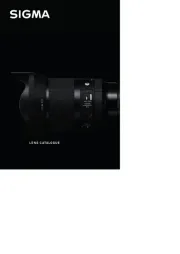
31 Augusti 2025
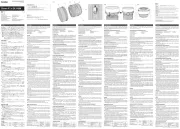
31 Augusti 2025

18 Augusti 2025
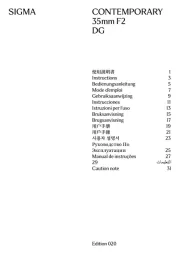
4 Juli 2025

4 Juli 2025

3 Juli 2025

3 April 2025

31 December 2025

31 December 2025

31 December 2025
Lins Manualer
- Laowa
- Trendnet
- Voigtlander
- Angénieux
- Godox
- ECS
- NiSi
- Marshall
- Hasselblad
- Tokina
- Brinno
- Pelco
- Fujinon
- Astera
- DENZ
Nyaste Lins Manualer

11 Oktober 2025

8 Oktober 2025
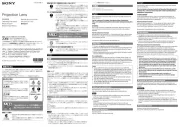
8 Oktober 2025

7 Oktober 2025
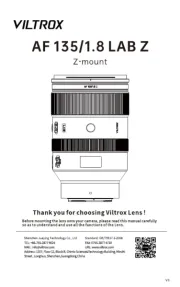
6 Oktober 2025

6 Oktober 2025

6 Oktober 2025

6 Oktober 2025

6 Oktober 2025

6 Oktober 2025